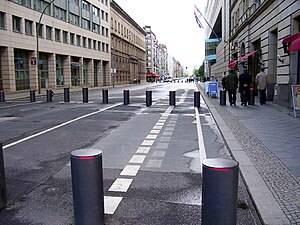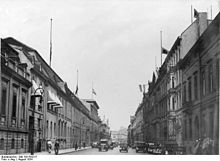Wilhelmstrasse

Wilhelmstrasse(German:Wilhelmstraße,seeß[1]) is a majorthoroughfarein the centralMitteandKreuzbergdistricts of Berlin, Germany. Until 1945, it was recognised as the centre of the government, first of theKingdom of Prussia,later of the unifiedGerman Reich,housing in particular theReich Chancelleryand theForeign Office.The street's name was thus also frequently used as ametonymfor overall German governmental administration: much as the term "Whitehall"is often used to signify the British governmental administration as a whole. In English," the Wilhelmstrasse "usually referred to the German Foreign Office.[2]
Course[edit]
The Wilhelmstraße runs south from theSpreeriverside through the historicDorotheenstadtquarter to theUnter den Lindenboulevard nearPariser PlatzandBrandenburg Gate,where it takes on a line slightly east of south through adjacentFriedrichstadt,until its juncture with Stresemannstraße nearHallesches Torin Kreuzberg, an overall distance of about 2.4 km (1.5 mi).
Further south ofUnter den Lindenit passes the nowadays built-over formerWilhelmplatzvis-à-visVoss-Straße,it crossesLeipziger StraßenearLeipzigerandPotsdamer Platz,andNiederkirchnerstraße,known until after World War II asPrinz-Albrecht-Straße.At its southern end, Wilhelmstraße originally met withFriedrichstraße,which runs roughly parallel to the east, on theBelle-Alliancecircus, before the street course was westerly redirected to the Stresemannstraße junction about 1970.
Between Unter den Linden and parallel Behrenstraße, the road is closed for motor vehicles as a protection of theEmbassy of the United Kingdom.
History[edit]
Frederick William I,from 1713King in PrussiaandElector of Brandenburg,had the southwestern Friedrichstadt quarter of his Berlin residence significantly enlarged, whereby the premises up to theBerlin Customs Wall(on present-day Stresemannstrasse) were developed as an affluent residential area. In 1731 theHusarenstraße(Street of theHussars) was built as a north-south thoroughfare of theBaroquecity layout, where manyHuguenots,who had fled fromFrance,as well as expelled members of theMoravian Churchsettled. Several personal confidants of the king had large city palaces erected, most notably GeneralKurt Christoph Graf von Schwerinand the French Baron François Mathieu Vernezobre de Laurieux, who took his residence in the laterPrinz-Albrecht-Palais.The street was renamedWilhelmstraßein honour of the king, who had died in 1740.
Government district[edit]

Originally a wealthy residential street, with a number of palaces belonging to members of theHohenzollernroyal family, the Wilhelmstrasse developed as a Prussian government precinct from the mid 19th century. In 1858 KingFrederick William IVacquired the formerPalais Schwerinon No. 73. This building now calledPalace of the Reich Presidenthoused an administrative seat of the Prussian minister for the Royal Household, from 1861 led byAlexander von Schleinitz.In 1869 the nearbyPalais Schulenburgresidence of late PrinceAntoni Radziwiłł,built in 1738/39 on No. 77, was purchased by the Prussian state government at the behest of Schleinitz' opponent Minister-PresidentOtto von Bismarck.Rebuilt from 1875 until 1878, it served as his official seat asGerman chancellor.The next door building on No. 76 was used for the chancellery's Foreign Office department.
Several further governmental departments took their seat on Wilhelmstrasse, such as theReich Ministry of Finance(No. 61), theImperial Colonial Office(No. 62), thePrussian state ministry(No. 63), theReich Ministry of Food and Agriculture(No. 72), and theReich Ministry of Transport(No. 79, from 1919). The lavishPalais Strousbergof bankrupt "railway king"Bethel Henry Strousbergon No. 70 was bought by Prince Hugo ofHohenlohein an 1876 auction and rented out to theBritishambassadorLord Ampthill,until it was finally purchased by the United Kingdom in 1884. In 1877 theBorsig Palacewas erected on the corner with Voss-Strasse.
Weimar Republic and Nazi years[edit]

After World War I thePalais Schwerinwas sold by exiled EmperorWilhelm IIto theWeimar Republicgovernment and in 1919 became the residence of the firstReich Presidentof Germany,Friedrich Ebert.Until the death of his successorPaul von Hindenburgin 1934, the President's official residence was atWilhelmstraße 73,where he could watch the torchlight parade on the night of the NaziMachtergreifungon 30 January 1933, after he had sworn inAdolf Hitleras German chancellor. Hitler addressed the cheering crowds on Wilhelmstasse from a window of a modern chancellery annex building erected in 1930. Styling himself "Führerand Reich Chancellor "from 1934, he regarded the residence inadequate and ordered the construction of the vastNew Reich Chancelleryaccording to plans designed byAlbert Speer.This building, a prime example ofNazi architecture,stood immediately south of the old Chancellery, on the corner of the Wilhelmstrasse and theVoss Strasse,and its official address wasVoßstraße 4.
The Foreign Office moved into the former Reich President's palace, the old building being refurbished in grandiose style at the behest of Nazi MinisterJoachim von Ribbentrop.Vis-à-vis on Wilhelmplatz, the BaroqueOrdenspalaiswas refurbished as seat of theMinistry of Public Enlightenment and Propagandaled byJoseph Goebbels.In 1935/36 his party fellowHermann Göringhad the hugeMinistry of Aviationedifice designed byErnst Sagebielbuilt on the corner with Leipziger Strasse. The adjacentPrinz-Albrecht-Palaisin the south became notorious as the seat of theSicherheitsdienstof theReichsführer-SSand theSicherheitspolizeichief-of-staff; merged into theSS-Reichssicherheitshauptamtterror complex underReinhard Heydrichin 1939. Most of the public buildings along Wilhelmstrasse were destroyed byAllied bombingduring 1944 and early 1945 and during the followingBattle of Berlin.
Cold War[edit]

After the war, Wilhelmstrasse as far south as Niederkirchnerstrasse was in theSovietsector of Allied-occupied Berlin, and apart from clearing the rubble from the street little was done to reconstruct the area until the founding of theGerman Democratic Republic(GDR) in 1949, withEast Berlinas its capital. One of the earliest reconstructions was the 1948-built provisional wooden church hall of theMoravian Brethrencongregation on Wilhelmstrasse 138.
ThecommunistGDR regime regarded the former government precinct as a relic of Prussian and Nazi militarism and imperialism, and had all the ruins of the government buildings demolished in the early 1950s. In the late 1950s there were almost no buildings at all along the Wilhelmstrasse from Unter den Linden to the Leipziger Strasse. The only major surviving public building in the Wilhelmstrasse was just Göring'sReich Air Ministry,which had escaped major damage during the war. As one of the few intact government buildings in central Berlin, it was used by theSoviet Military Administration in Germanyand the (East)German Economic Commission,later by theGerman People's Councilof theSoviet occupation zone,itsPeople's Chambersuccessor and several East German ministries and government departments. AsHaus der Ministerienit was at the centre of the popular demonstrations during theworkers' uprising of 17 June 1953.
The building of theBerlin Wallin 1961 cut the street in half. In 1964 the East Berlin section of the street was named after the former GDR Minister-presidentOtto Grotewohl,who had died in office on September 21. Several embassies of "befriended" countries were erected on the corner with Unter den Linden from about 1970 onwards. The new embassy building of theCzechoslovak Socialist Republicwas erected from 1974 to 1978 on Wilhelmplatz. In the 1980s, severalPlattenbau(concrete slab) apartment blocks were built on the cleared premises along East BerlinOtto-Grotewohl-Straße.The flats were quite popular among thenomenklatura,as they provided an undisturbed view across the Wall's towardsWest Berlin.The former "death strip" is today the site of theMemorial to the Murdered Jews of Europe.
Today[edit]

Today, the Wilhelmstraße is an important traffic artery, but has not regained its former status. SinceGerman reunification,some federal ministries have moved their seats to Wilhelmstraße, such as theMinistry of Labour and Social Affairson former Wilhelmplatz, theMinistry of Financein the former Reich Ministry of Aviation complex (renamedDetlev-Rohwedder-Hausin 1992), as well as theFederal Ministry of Food, Agriculture and Consumer ProtectiononWilhelmstraße72 – the only German government ministry now located on its prewar site although in a partly reconstructed building.
The British Embassy, whose original building had been destroyed by bombing, was rebuilt on the site.Queen Elizabeth IIofficiated at the grand opening in July 2000. Other public institutions on Wilhelmstraße include theARD-Hauptstadtstudio(television studio) of theARDbroadcasting organization at the northern Spree riverside, theE-Werktechno club, theTopography of Terrormuseum at the formerReichssicherheitshauptamtsite, and theWilly-Brandt-Hausheadquarters of theSocial Democratic Party of Germanyon the southern corner with Stresemannstrasse.
Many of the occupants of the GDR apartment blocks are recent immigrants, and there are a number of shops and restaurants catering toRussiansandTurks.In recent years the City of Berlin has placed a series of historical markers along Wilhelmstraße, showing where the well-known buildings of the pre-war era stood. On 8 November 2011 a memorial in honour of the failed assassinJohann Georg Elserwas inaugurated at the site of the former Reich Chancellery.
Notes[edit]
- ^For the spelling, see,inter alia,Paul Seabury:The Wilhelmstrasse,Joachim Joesten,The "New" Wilhelmstrasse,and the works ofGeorge Frost Kennan.TheOxford Illustrated Dictionarygives only this spelling; so do the Second Edition of theOxford English Dictionary,and all five of its quotations.
- ^SeeDaisy, Princess of Plessby Herself, p. 63.OED,"Wilhelmstrasse"
External links[edit]
 Media related toWilhelmstraße (Berlin-Kreuzberg/Mitte)at Wikimedia Commons
Media related toWilhelmstraße (Berlin-Kreuzberg/Mitte)at Wikimedia Commons- Wilhelmstrasse in Berlin online street maps
- The Historical Wilhelmstraße(in German)
- Wilhelmstraße during the Third Reich and today
- reconstructed Wilhelmstraße 62 and 76-80
